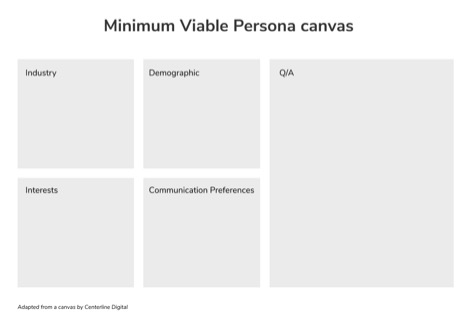
by Andrea Fryrear, author of “Mastering Marketing Agility“
The profound transformations in the world over the past 3 months have led to a radical and rapid fire transformation of consumers’ preferences and needs.
Tone and topics, channels and character, messaging and media – everything has been in a state of flux as the world undergoes a dramatic transformation.
That means in order to maintain a connection, marketers have to get to know their customers all over again. But the traditional approach of spending many months conducting surveys to craft perfect, data-centric customer personas and buying journeys just isn’t going to cut it in these fast-changing times.
Instead, we need to streamline and accelerate our processes by borrowing techniques from the world of lean and agile product development. These frameworks show us how to start working from a small amount of information, learn quickly, and iterate often. The first step as we navigate our changing customer needs is to create a Minimum Viable Persona, or MVP.
Why Minimum Viable Personas.
An MVP’s goal is to help us uncover the most actionable and important pieces of information about our audience as quickly as possible. You’ll note that it still has the word “viable” in its name, meaning it’s still able to live on its own.
Like its cousin the Minimum Viable Product, a Minimum Viable Persona seeks to provide just enough information to allow work to start.
Consider the example above, which is primarily for a B2B audience. It’s just asking us to clarify the industry our persona works in, what interests they have, a few demographic nuggets, and their core communication preferences. With this data we can begin to create messaging designed to resonate with this person.

The biggest area of the canvas is deliberately reserved for questions and answers, because much of our work as marketers getting to know our customers again is devoted to learning. We want to listen, observe, and analyze data to see how our work is being received.
But it’s only by starting to put things out in front of our audience that we’ll be able to make these discoveries. We can sit and collect hypothetical data for months, but it still won’t guarantee that our messaging will be on target.
That’s the power of the MVP, and of lean and agile approaches in general. They embrace a lack of knowledge and plan for frequent iteration.
An Exercise to Generate Your MVP.
If you’re struggling with completing your MVP canvas, here’s a simple exercise that can help. It’s goal is to tap into existing knowledge of your customer base by using four objects that you know are meaningful to your persona.
Step 1:
Ask someone who you’re confident represents your persona to gather four objects reflecting their ideas, behavior, and personality with a focus on the ultimate transaction you’re hoping to make with them. For instance, if you’re selling athletic shoes, the four objects might be: a stack of books on running topics, screenshots of podcasts on living a healthy life-style, athletic-style headphones, and medals and bibs from races.
Step 2:
Gather a group responsible for communicating with this audience member. Most likely you’ll have marketing, sales, and customer experience/success/service in the room. You may also want to bring in executives and other leaders, but be mindful of whether their role might negatively impact the ideation process.
Step 3:
Ask the group to look at the objects and fill out a Minimum Viable Persona Canvas like the one above. The goal is to gain consensus around core traits of the audience that will form the foundation of your marketing messaging, along with several hypotheses that can be tested with marketing or sales efforts.
With this complete, you can move forward quickly from an informed position.
What to Do With Your MVP.
Once your MVP is in place, your work isn’t done. It’s time to begin testing and learning. Begin using the MVP as the foundation for creating new marketing materials, and carefully monitor the reaction you receive.
(For more detail on how to design projects that allow for this test and learn mentality, check out my new book “Mastering Marketing Agility” for a complete Agile marketing framework.)
As data comes in, adjust and expand your MVP canvas to reflect what you learn. Over time you may find that the canvas naturally grows, eventually resembling a more traditional persona diagram. But this time its contents came from real interactions with an audience, not months of data collection and analysis.
The ability to move quickly has always been vital in marketing, but as our audience and our world continue to morph, speed is more important than ever.

Andrea Fryrear is co-author of the ICAgile Certified Professional in Agile Marketing curriculum, author of two books on marketing agility, and an internationally sought-after speaker and trainer. She holds numerous Agile certifications, including Advanced Certified Scrum Product Owner (A-CSPO), ICAgile Certified Instructor, Certified Professional in Agile Marketing (ICP-MKG), Certified Scrum Master (CSM), Certified Agile Leader (CAL-1), Certified Scrum@Scale Practitioner, and Certified Professional in Agile Coaching (ICP-ACC).
The post Minimum Viable Persona – Get To Know Your Customers All Over Again appeared first on Young Upstarts.
from Young Upstarts https://ift.tt/2CFubtB via website design phoenix

No comments:
Post a Comment